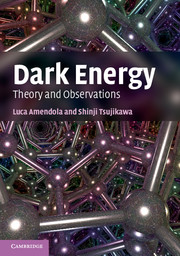Book contents
- Frontmatter
- Contents
- Preface
- List of Frequently used symbols
- 1 Overview
- 2 Expansion history of the Universe
- 3 Correlation function and power spectrum
- 4 Basics of cosmological perturbation theory
- 5 Observational evidence of dark energy
- 6 Cosmological constant
- 7 Dark energy as a modified form of matter I: Quintessence
- 8 Dark energy as a modified form of matter II
- 9 Dark energy as a modification of gravity
- 10 Cosmic acceleration without dark energy
- 11 Dark energy and linear cosmological perturbations
- 12 Non-linear cosmological perturbations
- 13 Statistical methods in cosmology
- 14 Future observational constraints on the nature of dark energy
- 15 Conclusion and outlook
- 16 Answers to the problems
- 17 Mathematical Appendix
- References
- Index
4 - Basics of cosmological perturbation theory
Published online by Cambridge University Press: 05 March 2013
- Frontmatter
- Contents
- Preface
- List of Frequently used symbols
- 1 Overview
- 2 Expansion history of the Universe
- 3 Correlation function and power spectrum
- 4 Basics of cosmological perturbation theory
- 5 Observational evidence of dark energy
- 6 Cosmological constant
- 7 Dark energy as a modified form of matter I: Quintessence
- 8 Dark energy as a modified form of matter II
- 9 Dark energy as a modification of gravity
- 10 Cosmic acceleration without dark energy
- 11 Dark energy and linear cosmological perturbations
- 12 Non-linear cosmological perturbations
- 13 Statistical methods in cosmology
- 14 Future observational constraints on the nature of dark energy
- 15 Conclusion and outlook
- 16 Answers to the problems
- 17 Mathematical Appendix
- References
- Index
Summary
In this chapter we present the basics of linear perturbations in cosmology. After a general introduction of cosmological perturbation theory, we work out several cases: (i) single pressureless perfect fluid, (ii) single general perfect fluid, and (iii) two fluids: matter and radiation. We also discuss a number of topics such as the velocity field, the redshift distribution, Boltzmann equations, the matter power spectrum, and the perturbed photon propagation. These provide us with important tools when we confront dark energy models with observations of the cosmic microwave background (CMB) and large-scale structure (LSS).
In this chapter the treatment and notation are fairly standard and the topic is covered in most modern textbooks on cosmology. Readers familiar with cosmological perturbation theory may skip this chapter.
Perturbing General Relativity
In Chapter 2 we have outlined the cosmic expansion history in the homogeneous and isotropic FLRW background. However, our Universe is far richer than this simple picture. A metric that deviates from the FLRW spacetime can be written as the sum of an unperturbed FLRW part plus something else, that we can generally call “perturbed” metric. If the perturbed part is assumed to be small, in a sense to be defined later, then this splitting of the full metric into a background part and a perturbed one leads to extremely useful results. As we all know, physics is to a large extent described by a Taylor expansion to some low order, and cosmology is not an exception.
- Type
- Chapter
- Information
- Dark EnergyTheory and Observations, pp. 40 - 83Publisher: Cambridge University PressPrint publication year: 2010



